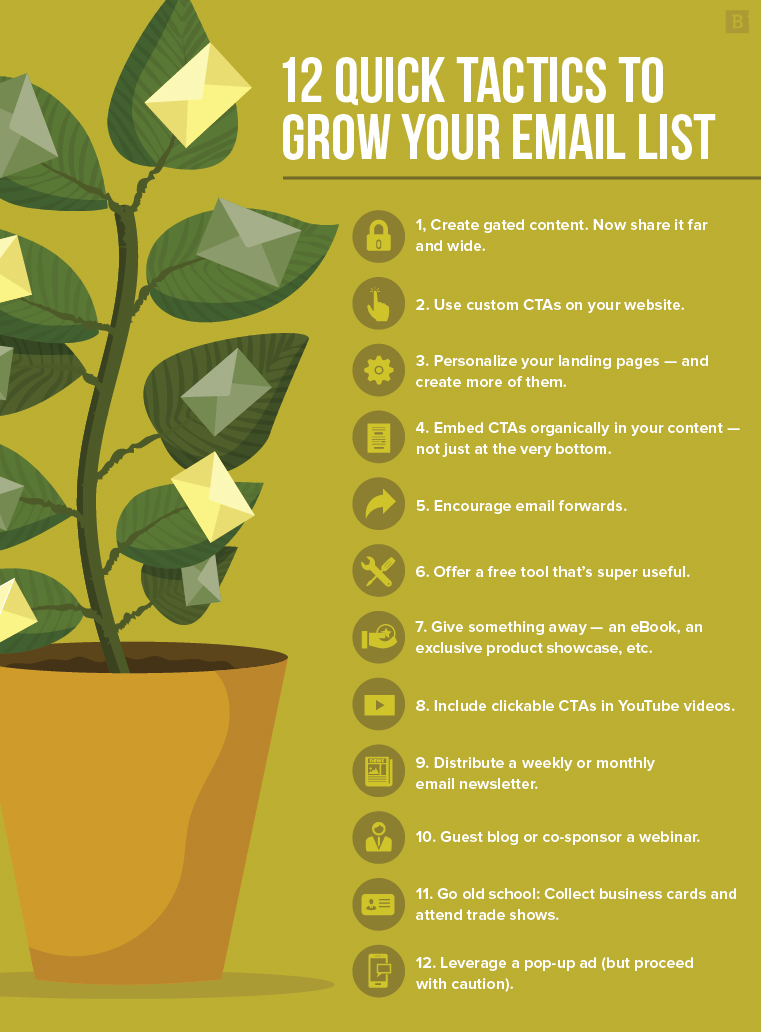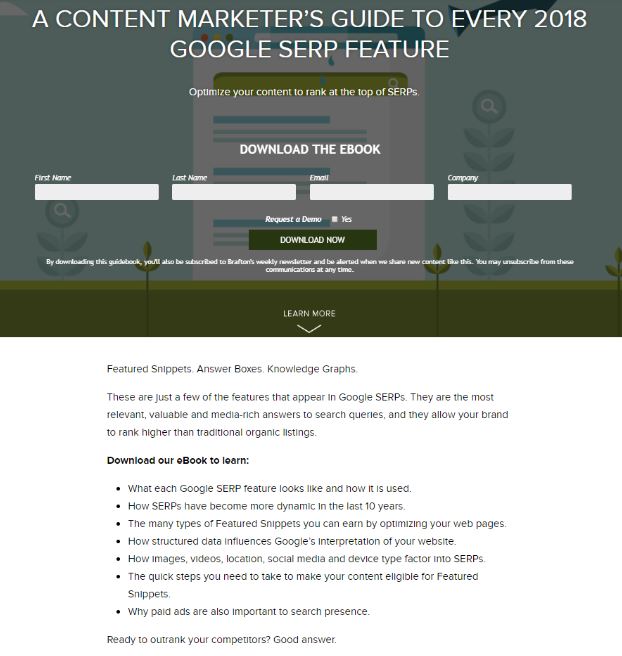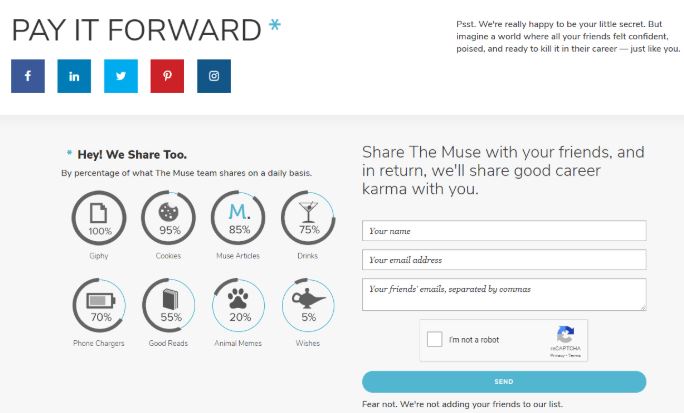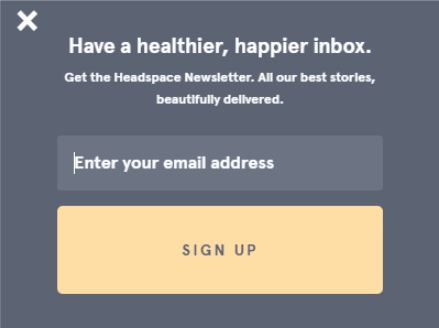Nearly half the world’s population uses email.
Sure, that includes your mom, who still hasn’t made it past the “If you don’t forward this email to 25 friends, you will die this Friday” phase of her inbox. (Gosh I miss AOL.)
But it also includes prospects within your target market and executives who are ready to do business with you.
An email list is a comprehensive catalog of all your email recipients, segmented and organized in a way that makes sense to your organization. Your job is to build that list via email opt-in and sign-up forms. The more subscribers you have in your rolodex, the more likely it is your emails will land in the inbox of a high-value lead.
A good list is a genuine business asset to your company, loaded with data points about your customers and prospects. A bad list, however, will result in hundreds of bouncebacks and spam responses from bots with less email etiquette than your mom circa 1999.
An email list is a comprehensive catalog of all your email recipients, segmented and organized in a way that makes sense to your organization.
What’s in an email list?
It’s rather simple, really.
An email list contains the email addresses and the names of recipients who have subscribed to your organization’s email. It might also show the content of previous emails you’ve sent to those on the list, as well as the reflector email your company uses to more quickly distribute content.
For example, I might set up a listserv for “Newsletter Subscribers” and a reflector address as newslettersubscribers@brafton.com. As a marketing manager, all I have to do is create and format a single email that I want everyone on our newsletter distribution list to see. But instead of manually sending an email to each recipient, I just send one to the reflector address, which subsequently sends the email to the entirety of subscribers designated under that umbrella.
Exactly why is an email list so important?
How many times do you get to converse with a customer beyond the first interaction? How do you reconnect with someone who put your products in an online shopping cart but may have abandoned them before making a purchase?
An email list allows you to categorize individuals by these precise triggers and then nurture them with emails. This keeps you front and center with potentially lucrative customers, and if you distribute coupons, discounts and loyalty rewards offers, you’re sure to generate additional interest in repeat visits.
Without an email list, this level of engagement would not be possible. You’d be relying on paid ads, direct web traffic or social media touchpoints, otherwise. Isn’t it great to have contact info on speed dial? That’s why the importance of building an email list cannot be overstated.

Create an email list from scratch
So how do you get started? What type of information is needed from email subscribers? Which sign-up forms work the best?
List building is all about making contact. You need to put your brand out there – through your website, social feeds, guest forums, industry events and more. Once you’re in front of potential leads, you need their contact info: just a simple name and email address works for starters. (We’ll get in to opt-in form best practices in moment.)
Here are a number of ways to grow your email list:
1. Create gated content. Now share it far and wide
We’re talking eBooks, white papers, long-form customer testimonials and anything your company can offer that goes beyond a traditional blog. Gate these assets behind a form fill on distinct landing pages. That way, site visitors must provide their email addresses to access your awesome content.
2. Use custom CTAs on your website
Calls to action are one of the best ways to measure marketing ROI, and they shouldn’t be exclusive to just your emails or your larger assets. Put CTAs in your blog posts and landing pages as well – these buttons can then direct interested traffic to form fills.
3. Personalize your landing pages – and create more of them
One of the best ways to get more out of your website isn’t to ramp up blog post production but to expand your number of core landing pages. Crafting new landing pages around specific search terms and the user intent behind them provides a very targeted, personalized experience for visitors to your site. It’s what we do, and it works: 70 percent of our product landing pages rank on page one of Google for our targeted keywords. Stick some form of a CTA like “Contact Us” on those landing pages and you’ve just generated middle-of-the-funnel, high-intent email contacts to add to your distribution list.
4. Embed CTAs organically in your content – not just at the very bottom
Honestly, if it’s content, it needs a CTA. What other reason is there for people to scroll through your pages if you’re not providing them actionable next steps to take. For your purposes, that next step should be to capture their contact information. Embedding CTAs (you can do more than one!) throughout content is best practice – sticking them only at the bottom means you’re missing out on potential leads who never made it to the end of your article.
5. Encourage email forwards
If you’re already sending out emails – whether they be promotional, educational or part of a drip – overtly ask for recipients to forward along to their bosses, colleagues and peers. A newsletter, for instance, could prove valuable to these subsequent recipients and prompt them to subscribe as well. Plus, people deem forwarded emails more trustworthy than cold emails and open them more often.
6. Offer a free tool that’s super useful
Online calculator. Grammar checker. Text formatter. Whatever it is, people love free and useful.
Offering a free tool on your site drives a lot of traffic and those people are likely to share with their friends or colleagues as well. Simply ask for an email address before allowing full access and, boom, your email list is instantly larger.
7. Give something away – an eBook, an exclusive product showcase, etc.
We all love VIP treatment. If you’ve got a great new resource like proprietary research or an in-depth white paper that’s soon to launch, solicit contact information from site visitors by teasing instant or early access to these assets. You can do the same for new products you’re launching by offering certain people or organizations to beta test for improvements.
8. Include clickable CTAs in YouTube videos
Video content is growing and growing. And YouTube enables you to include clickable CTAs directly in your videos’ “End Cards.” Optimize your vids for this feature, in addition to verbally requesting viewers “subscribe below” by clicking the red subscribe button. And there’s another email.
Find more on YouTube optimization here – you’ll thank us later.
9. Distribute a weekly or monthly email newsletter
Newsletters are wonderful, practical assets. You can use them to power your email campaigns and to stay in constant contact with your existing customers and readers. Be sure to place a subscribe button at the bottom of your newsletters so that those who receive your content via forwards can follow you as well.
10. Guest blog or co-sponsor a webinar
Outside of your owned media properties (website and social channels), you need to be posting valuable content on third-party sites that are relevant to your audience and industry. You can also run joint webinars on topics of interest, which greatly expands your brand reach and puts your content in front of new audiences that may want to follow you. Additionally, webinars feature more extensive form fill requirements, allowing you to capture not only names and emails but job titles, industry verticals, company sizes and even reason for joining.

11. Go old school: Collect business cards and attend trade shows
Physical marketing still works, even if it may take longer or require more effort. A face-to-face meeting with a high-intent lead is likelier to respond to your emails than someone via LinkedIn whom you’ve never actually met.
12. Leverage a pop-up ad (but proceed with caution)
From time to time we experiment with small pop-ups on our site to see how valuable they can be. Well, we increased newsletter subscriptions by 532 percent pretty darn easily. You can do the same, just make sure you’re not in violation of Google’s updated interstitial guidelines.
Email sign-up forms: Make or break time
The specific design of your contact forms can either incentivize or deter a prospect from fully filling them out, if at all. Here’s a bit of counsel on what you can learn from top brands:
Example 1: Brafton

Here you can see all we request are name, email and company. Plus we clearly state that recipients are opting in to receive future email alerts but can opt out at any time – aka, we’re being honest with ya.
The text is sparse, what you’re getting yourself into is explicit and there is enough formatting to focus your attention on what we need from you.
Example 2: Moosejaw

This one’s a bit different. It’s sticks at the bottom of the page regardless of how you scroll, so it’s always present. Also, look how simple this is? No clicks required: just type your email address and hit enter. And who doesn’t like 10% off their first order by signing up and a little humor in the teaser text?
Example 3: The Muse

Just look at the subtle humor and conversational tone used here. Also, I’ve personally never seen a brand be so upfront with what they will be sending you should you sign up for their email list. The Muse goes so far as to provide you a percentage breakdown of the types of content you can expect on a daily basis – now that’s a company policy I could support!
Example 4: Headspace

A small pop-up in the bottom right corner of the page, this opt-in form is unassuming and casual. It also aligns with the Headspace brand, using terms like “healthier,” “happier” and “beautifully delivered.”
All they’re requesting is an email address, a small ask. Even if I was uncertain exactly what Headspace could provide me, the mere thought of my inbox (and by extension, me) being healthier and happier is encouragement enough: Of course I want that, so here’s my email.
Tools, platforms and providers to get you started
Opt-in forms are shockingly easy to create because there a plenty of email marketing platforms that do all of the work for you. Another great thing is that many tools offer integrations with various CRMs and email service providers, meaning the data you enter into one can be easily transferred to others.
Here are a few helpful options to keep on your radar:
More than just marketing: Putting your email list to work for your business
If emails make your eyes gloss over, and your growing inbox just downright gives you the shivers, remember one thing: Retaining one customer is five times cheaper than attracting a new one.
Email lists are invaluable customer-retention tools. You have their info, now DO something with it!
With just one email, you can place a customer into an email drip campaign to ensure they remain committed to your brand.
And for those individuals who aren’t yet customers but could be soon, a steady lead-nurturing campaign via email can prove your company’s value on a consistent basis. Once they’re ready to purchase, they’ll know who to turn to: the brand that delivers value directly to their inbox and makes a concerted effort to win their business.
Any other cool ideas on growing your email list? We’d love to hear ‘em!





